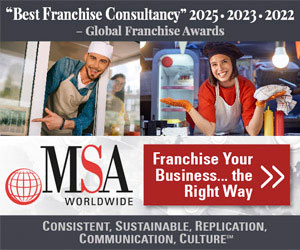3 Keys To A Successful Restaurant Sale

It wasn't too long ago, in the midst of recession, the idea of selling a restaurant would have been fleeting at best.
Today, the idea makes sense for a variety of reasons, especially because there are plenty of investors available who are aggressively looking for places to spend their money. And many of them have their eyes on the restaurant industry.
Why? There are several reasons restaurants are attractive to investors:
- Because of their general concern about the stock market
- The superior performance of restaurant public equities against the stock market over the last several years (the restaurant industry has significantly outperformed the stock market since 2008)
- Their desire for greater yield than that provided by bonds or real estate
- Predictable cash flow and high direct operating leverage.
All of this makes for a very compelling window of opportunity for restaurant owners who've been toying with the idea to make their move in selling their business. To prepare the sale, though, you'll need to take some steps to ensure success. Here are three important ones.
Evaluate What Your Business is Worth
Restaurant valuations are primarily based on cash flow and real estate values, which can include leasehold and other derivative forms of land, buildings, or equipment. Other factors that can contribute significant value but are not reflected in these items include:
- The amount of time remaining on a lease and whether or not it is above or below market rent
- The condition of the building and equipment and whether or not it meets competitive standard
- The remaining years on a franchise agreement (if the unit is franchised)
- The trend line of the restaurant's performance (and the concept performance in the case of a franchise)
- The demographics of the restaurant's customers and geography.
Investment bankers typically look at earnings before interest, taxes, depreciation, and amortization (EBITDA) as a proxy for a restaurant company's cash flow. The price of restaurant transactions is frequently determined by a multiple of this cash flow. This, however, is a blunt instrument at best.
For example, if ABC Restaurant has $150,000 of EBITDA and it is sold at a 5.0x multiple, then the transaction value will be $750,000 (ignoring any real estate and other adjustments). This is a fairly simplified yet common rubric for determining restaurant company sale prices.
Investment bankers, as well as potential buyers, will analyze many other non-EBITDA related aspects of a restaurant in order to refine the valuation multiple that is most appropriate for each restaurant. If we expand on the example above, let us assume ABC Restaurant is 40 years old and has $200,000 of deferred capital expense. With that in mind, a potential buyer is more than likely going to meaningfully reduce their proposed acquisition price of $750,000, and thus lower the valuation multiple below 5.0x. Therefore, it is important to remember that cash flow times multiple can often be a major oversimplification of restaurant valuation.
The current market environment continues to support very attractive valuation multiples, as financing and liquidity have become more aggressive and plentiful, respectively. In fact, more than 70 percent of private equity deals across the broad market were at a multiple of 5.0x or greater in seven of the last eight quarters, and nearly 50 percent of deals were at a multiple of 7.5x or greater in the last two quarters.
More specifically, our internal database of restaurant transactions shows a steady increase in purchase price multiples, particularly over the last 12 months.
Get Your House in Order
The most important thing to keep in mind about valuing restaurants is making sure your company has been optimized for sale. This does not mean you should make misleading financial adjustments; it means you should review your accounting treatment and any business practices that may understate the true normalized cash flow of the company. Examples of these items can include accounting treatment of repairs and maintenance, capitalization of items, nonessential or unrelated business costs in general and administrative expense, tax management, tenant improvement amortization, and net operating losses.
It is also imperative to tell the story of what your company can accomplish and what may not be reflected in financial statements. This can include demographic trends, development rights, management experience, lease and/or franchise agreement longevity, vendor contracts, trademark rights, brand equity, and other nuances that can maximize value.
Understand Your Exit Options
How much of the company should you sell? Two general principles to consider are that you maximize price when you minimize transferred risk and that integrity of the other party in the transaction is critical.
If you sell 80 percent or so of your company and retain 20 percent, your message to the buyer is that I believe in this company enough to keep 1/5th of the business, but give up the control. This very powerful statement validates your confidence in the business management, profitability, and future.
Selling a minority interest can produce good proceeds without a change in control and perhaps lead to a subsequent transaction in the future. It generally provides the option to repurchase the minority interest under certain conditions.
Conversely, when selling the entire business, be careful to not convey that the sale is predicated on a transfer of risk, such as expiring leases, declining sales, ineffective product, pricing and promotion, or changing demographics and traffic patterns.
Choose your buyer carefully. There is an adage that you cannot do a good deal with a bad guy. Being a partner or counterparty with somebody who doesn't share your philosophy, doesn't communicate properly, is an erratic steward of the cash flow or is headed for a disaster can not only be a financial catastrophe, but can also present nonmonetary costs of pain and suffering, as well as reputational damage.
Sometimes the sale of a business is not the right answer for an exit strategy. Some families have children in the business who are actually good stewards of the family's interests. In the case where cash flow is required by a retiring family shareholder, a comprehensive recapitalization can occur, which will generate loan proceeds without conveying any of the family's stock in the business. This has the added advantage of typically not generating any tax liability unless the loan proceeds are significantly higher than the adjusted tax basis.
Clearly in today's environment, it's a seller's market. The best advice when deciding whether or not to sell your company is to confer with experienced professionals who can advise you as to the best path to your goals.
Kevin Burke is Managing Director of Trinity Capital.
Share this Feature
Recommended Reading:
| ADVERTISE | SPONSORED CONTENT |
FRANCHISE TOPICS
- Multi-Unit Franchising
- Get Started in Franchising
- Franchise Growth
- Franchise Operations
- Open New Units
- Franchise Leadership
- Franchise Marketing
- Technology
- Franchise Law
- Franchise Awards
- Franchise Rankings
- Franchise Trends
- Franchise Development
- Featured Franchise Stories
| ADVERTISE | SPONSORED CONTENT |

$500,000
$125,000





 The multi-unit franchise opportunities listed above are not related to or endorsed by Multi-Unit Franchisee or Franchise Update Media Group. We are not engaged in, supporting, or endorsing any specific franchise, business opportunity, company or individual. No statement in this site is to be construed as a recommendation. We encourage prospective franchise buyers to perform extensive due diligence when considering a franchise opportunity.
The multi-unit franchise opportunities listed above are not related to or endorsed by Multi-Unit Franchisee or Franchise Update Media Group. We are not engaged in, supporting, or endorsing any specific franchise, business opportunity, company or individual. No statement in this site is to be construed as a recommendation. We encourage prospective franchise buyers to perform extensive due diligence when considering a franchise opportunity.